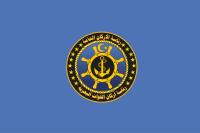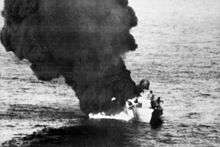Libyan Navy
| Libyan Navy | |
|---|---|
 Seal of the Libyan Navy | |
| Active | November 1962 – present |
| Country |
|
| Allegiance | Presidential Council |
| Type | Navy |
| Size | 2,800 personnel |
| Headquarters | Tripoli |
| Equipment | pre 2011: 41+ vessels |
| Commanders | |
| Minister of Defense | Al-Mahdi Al-Barghathi |
| Chief of Naval Staff | Hassan Ali Bushnak |
| Insignia | |
| Flag of the Libyan Navy |
 |
| Naval Ensign |
 |
| Naval Ensign (1977-2011) |
.svg.png) |
Libyan Navy is the maritime force of Libya, established in November 1962. It is a fairly typical small navy with a few missile frigates, corvettes and patrol boats to defend the coastline, but with a very limited self-defence capability. The Navy has always been the smallest of Libya's services and has always been dependent on foreign sources for equipment, spare parts, and training.
History
.svg.png)
Its first warship was delivered in 1966. These were 2 Ham class minesweepers from the UK. Initially the effective force was limited to smaller vessels, but this changed after the rise of Colonel Muammar Gaddafi in 1969. From this time, Libya started to buy armaments from Europe and the Soviet Union. The Customs and Harbour police were amalgamated with the Navy in 1970, extending the Navy's mission to include anti-smuggling and customs duties. The total personnel of the Libyan Navy is about 8,000.
During the 2011 Libyan civil war several elements of the Libyan Navy were destroyed by NATO forces, including 8 warships in the night before 20 May and one on 17 August.[1][2] Two were also captured by the rebels at Benghazi.
The Navy began the process of purchasing new boats in May 2012, mainly fast patrol boats for surveillance and border protection purposes, including the MRTP-20 fast attack boat.[3]
As of June 2012, the Libyan Navy has been headed by Commodore Hassan Ali Bushnak, Chief of Staff of the Libyan Naval Force. The British Royal Navy along with the Libyan Navy held joint exercises together at Dartmouth Naval College in the UK in June 2012.[4][5]
Libyan Navy ships under the command of Rida Issa, loyal to the internationally recognized Government of National Accord, took part in the operation to liberate the city of Sirte from ISIL. The Libyan Navy assisted ground forces and blocked off sea escape routes for the militants.[6] On 20 June 2016, the EU states announced that the naval mission in the Mediterranean Sea, Operation Sophia, will be extended until 2017, and will help train the Libyan navy and coast guard.[7]
Background
The Navy's primary mission is to defend the coast. A strengthening of the service was made in the 1970s; the Soviet Union sold six Foxtrot-class SSK submarines, and though two of them were only averagely serviceable, they became the main threats to the US Navy in the Mediterranean Sea. In the meantime, Libya bought four Russian Nanuchka class corvettes, that even in the export versions were well-armed and powerful ships. Another four Assad class corvettes were acquired from Italy. These had Otomat long range missiles (in the Mk.I version without datalink for in-flight course correction) and modern artillery. They were less well-armed as anti-aircraft ships than the Nanuchkas but, with a displacement almost twice that of a typical FAC, had ASW capabilities, with sonar and light torpedoes.
Actions

Libya's Navy first saw military action during an encounter with the United States Sixth Fleet in March 1986 in the Action in the Gulf of Sidra (1986), when one missile boat and a corvette were destroyed, and other ships were damaged by A-6s. Unusually, some of these attacks were performed, successfully, with CBUs like the Mk.20 Rockeye designed as an anti-tank weapon.
In July 1984, the Ro-Ro ferry Ghat is believed to have mined the Red Sea a few kilometres south of the Suez Canal. Approximately nineteen ships were damaged, including a Soviet container ship which was the first to be hit on 9 July. The Islamic Jihad Organisation took responsibility for the incident, however Egypt's President Hosni Mubarak did not believe the claims and blamed Muammar Gaddafi and Libya. Other sources agreed after it was learnt that the ship took fifteen days to complete a voyage that normally would take eight days, the head of the Libyan minelaying division was on board, and that, when inspected by French officials in Marseilles the aft door was damaged. Due to concerns about the safety and potential lost revenue from the canal, Egypt asked for assistance in sweeping the mines in a complex operation that involved mine-hunters from the French, British, Italian, Dutch, and US navies. The British located a Soviet-made mine, which was most likely sold to Libya after 1981 and was laid to cause problems for Egypt.[8]
[10] Ships (1985)
Ships (1985)

- 1 × Vosper Mk.7 frigate, Dat Assawari, (Built in UK, 1×114 mm Mk.8 gun, 2×40 mm/70 AA guns, 2×35mm/90 Oerlikon, 2×Seacat SAM, 1×Limbo Mk.10 ASW mortar. Upgraded in the 80s with Aspide SAM, OTOMAT SSMs, new search radar and other equipment)
- 4 × Assad class corvettes (Built in Italy, 1×76 and 2×35 mm guns, 6 tls, 4 OTOMAT)
- 3 of 4 × Nanuchka class corvettes, one sunk by US Navy in 1985. One damaged 25 March 1986, repaired in USSR 1990
- Some light units of Osa and Jaguar class (16×SS-12 missiles and 2×40 mm)
- 3 × Polnocny class landing ships
- One LSD ship
- Some minor vessels
Ships (2006)
Frigates

2 × Koni class frigates (Type 1159) (one operational)
- 212 Al Hani: (Captured by Rebels at Benghazi)
- 213 Al Ghardabia: (struck by NATO in Tripoli Harbour 20 May 2011)[11]
Armament:
Corvettes
- 416 Tariq-Ibn Ziyad: (Captured by Rebels)
- 418 Ain Zaara: (struck by NATO, 20 May 2011)
Armament:
- 4 × SS-N-2C Styx SSMs
- 2 × SA-N-4 SAMs
- 2 × 57mm guns MFPBs
MFPBs
9 × Combattante II fast attack craft (7 operational)
Armament:
- 4 × Otomat SSMs
- 1 × 76mm gun
- 2 × 40mm guns

12 × Osa class missile boats (Type II) (4 operational)
Armament:
- 4 × SS-N-2C Styx SSMs
- 4 × 30mm guns
Mine warfare vessels
9 × Natya class minesweepers (Type 266ME) (5 operational)
Armament:
- 4 × 30mm guns
- 4 × 25mm guns
- 2 × RBU 1200 A/S mortars
- 10 mines
- Acoustic & Magnetic sweep
In addition to several auxiliary and landing craft.
Oceanographic Research Ship
Nour, a former trawler converted in the 1970s. was stricken in 2002.
Submarines
6 × Foxtrot class submarine (1 left; not in commission)[12]
In 1982 Libya received six Foxtrot-class military submarines from the Soviet Union. However, since 1984, no submarine patrols are reported to have been conducted. In 1993 one submarine was reported sunk, and another one was abandoned in Lithuania due to international sanctions. Further reports circulated about one submarine being refitted in 2003, but they have since turned out to be false.[12] In 2011, during the Libyan civil war, one submarine (along with a frigate and a corvette) was captured by the rebels at the Benghazi naval base.[13]
Ships (2012)
Frigates
1 × Koni class frigate (Type 1159)[13]
Armament:
Mine warfare vessels
1× Natya class minesweepers (Type 266ME)
Armament:
- 4 × 30mm guns
- 4 × 25mm guns
- 2 × RBU 1200 A/S mortars
- 10 mines
- Acoustic & Magnetic sweep
Landing Ships
- 132 Ibn Ouf - Sighted in Toulon where she will be refitted[15]
- 134 Ibn Haritha - Sighted in Cassar shipyard in Malta where she will be refitted[15][17]
Naval Infrastructure
Naval bases in the 2011 Libyan civil war
- Khoms (bombed by coalition air strikes on 20 May 2011)[18]
- Benghazi
- Misrata
- Tobruk
- Tripoli (bombed by coalition air strikes on 20 May 2011)[18]
- Derna
- Sirte (bombed by coalition air strikes on 20 May 2011)[18]
Ship maintenance and repair facilities
Facilities at Tripoli with foreign technicians for repair of vessels of up to 6,000 tonnes deadweight (DWT); a 3,200-ton lift floating dock; floating docks at Benghazi and Tobruk.
Notes
- ↑ http://www.nato.int/nato_static/assets/pdf/pdf_2011_08/20110818_110818-oup-update.pdf
- ↑ AFP: NATO hits 8 Kadhafi ships as Obama predicts demise
- ↑ "Tactical Report".
- ↑ http://www.royalnavy.mod.uk/News-and-Events/Latest-News/2012/June/22/120622-Libya-Visit
- ↑ https://www.gov.uk/government/news/libyan-navy-visits-royal-naval-training-bases
- ↑ Desk, News (10 June 2016). "Libyan Navy asserts control over ISIL-controlled Sirte". Retrieved 2 July 2016.
- ↑ EU to train Libyan navy and coastguard. EUobserver. Published 20 June 2016. Retrieved 16 July 2016.
- ↑ Levie, Howard. Mine Warfare at Sea. Dordrecht, NL: Martinus Nijhoff, 1992. 159-62.
- ↑ "NATO Jet Bombs Libyan Army Boat". Military.com.
- ↑ "Libyan navy opens fire after tanker approaches mutinous port". Reuters. Retrieved 9 March 2014.
- ↑ "HMS Echo finds 18 wrecks in a remarkable mission".
- 1 2 "Submarine forces (Libya), Submarines - Submarine forces". Janes. 10 November 2010. Retrieved 11 March 2011.
- 1 2 Botti, David (25 February 2011). The New York Times http://video.nytimes.com/video/2011/02/25/world/africa/100000000664162/tc-022511-libya.html?ref=libya. Missing or empty
|title=(help) - ↑ "Media _DSC0117 – The Libyan Interim National Council". Ntclibya.org. 7 March 2011. Archived from the original on November 6, 2011. Retrieved 11 November 2011.
- 1 2 3 "Libyan frigate arrives in Malta for repairs".
- ↑ Wertheim, Eric (2007). The Naval Institute Guide to Combat Fleets of the World. Annapolis: Naval Institute Press. p. 448. ISBN 9781591149552.
- ↑ "LNS IBN HARITHA 134".
- 1 2 3 "NATO hits 8 Kadhafi ships".
References
- Levie, Howard. Mine Warfare at Sea. Dordrecht, NL: Martinus Nijhoff, 1992.
- War machines encliclopedy, Limited publishing, in Italian version Armi da guerra.
- Annati Massimo, Al diavolo le mine!, RID magazine, Coop Riviera Ligure, Italy, June 2005.
See also
- Free Libyan Navy
External links
| Wikimedia Commons has media related to Libyan Navy. |
- (English) Libyan navy